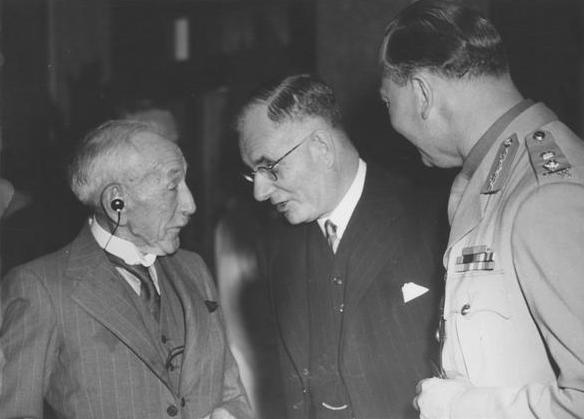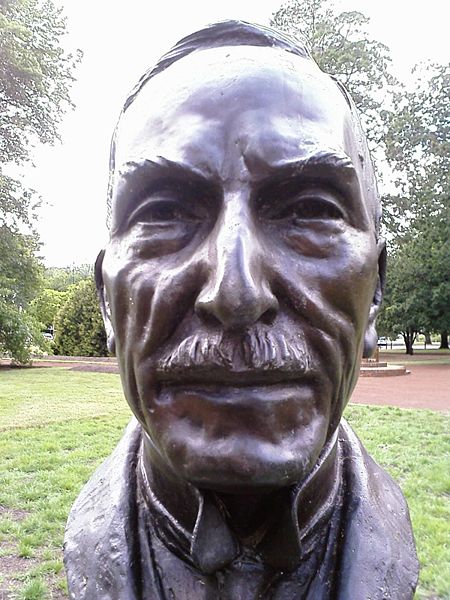<Back to Index>
- Geneticist Thomas Hunt Morgan, 1866
- Composer Jean Philippe Rameau, 1683
- 7th Prime Minister of Australia William Morris "Billy" Hughes, 1862
PAGE SPONSOR
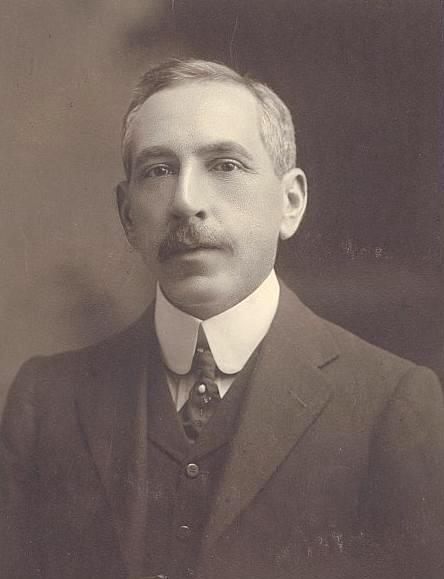
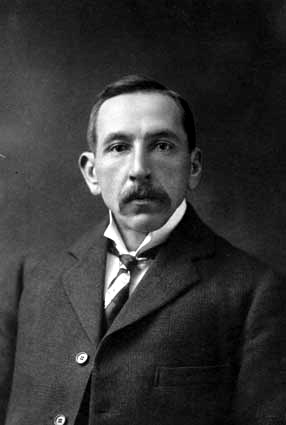
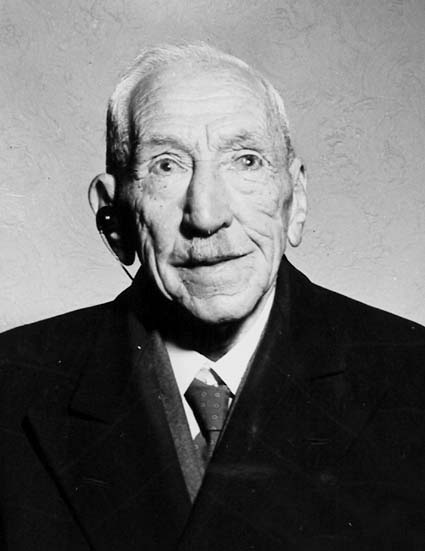
William Morris "Billy" Hughes, CH, KC (25 September 1862 – 28 October 1952), Australian politician, was the seventh Prime Minister of Australia from 1915 to 1923.
Over
the course of his 51 year federal parliamentary career (and an
additional seven prior to that in a colonial parliament), Hughes
changed parties five times: from Labor
(1901 – 16) to National
Labor (1916 – 17) to Nationalist (1917 – 30) to Australian (1930 – 31) to United
Australia (1931 – 44) to Liberal (1944 – 52). He was expelled from three,
and represented four different electorates in two states. He is the longest
serving member of the Australian Parliament, and one of the most colourful and
controversial figures in Australian political history. William
Morris Hughes was born in Pimlico,
London, on 25 September 1862 of Welsh parents. His father William
Hughes
was Welsh speaking and, according to the 1881 census, born in Holyhead, Anglesey,
North Wales, in about 1825. He was a deacon of the Particular Baptist
Church and by profession a joiner and a carpenter at the House of Lords.
His mother was a farmer's daughter from Llansantffraid, Montgomeryshire, and had been in service in
London. Jane Morris was thirty seven when she married and William
Morris Hughes was her only child. After his mother's death when
he was seven William Hughes lived with his father's sister in Llandudno,
Wales, also spending time with his mother's relatives in rural
Montgomeryshire, where he also spoke Welsh. A plaque on a guest house
in Abbey Road Llandudno bears testament to his residency. When he was
14 he returned to London and worked as a pupil teacher. In 1881, when
he was 19, William lived with his father and his father's elder sister
Mary Hughes at 78 Vauxhall Bridge Road, London. In
October 1884, at the age of 22, he migrated to Australia, and worked as
a labourer, bush worker and cook. He arrived in Sydney in 1886 and
lived in a boarding house in Moore
Park and established a common law marriage
with his landlady's daughter, Elizabeth Cutts. In 1890 they moved to Balmain where he at first worked for Lewy
Pattinson's pharmacy before he opened a small mixed shop,
where he sold political pamphlets, did odd jobs and mended umbrellas.
He joined the Socialist
League in 1892 and became a street-corner
speaker for the Balmain Single
Tax League and an organiser with the Australian
Workers' Union and may have already joined the newly
formed Labor Party. In
1894, Hughes spent eight months in central New South Wales organising
for the Amalgamated Shearers' Union and then won the Legislative
Assembly seat of Sydney-Lang by 105 votes. While in Parliament he became
secretary of the Wharf
Labourer's Union. In 1900 he founded and became first national
president of the Waterside
Workers' Union.
During this period Hughes studied law, and was admitted as a barrister
in 1903. Unlike most Labor men, he was a strong supporter of Federation. In
1901 Hughes was elected to the first federal Parliament as Labor MP for West Sydney.
He opposed the Barton
government's proposals for a small professional army and
instead advocated compulsory universal training. In 1903, he was admitted to the
bar after
several years part time study. His wife died in 1906, and his
17 year old daughter raised his other five children in Sydney. In 1911,
he married Mary Campbell. He was Minister for External Affairs in Chris
Watson's first Labor
government. He was Attorney - General in Andrew
Fisher's three Labor
governments in 1908 - 09, 1910 – 13 and 1914 - 15. He was the real political brain of these
governments, and it was clear that he wanted to be
leader of the Labor Party. But his abrasive manner (his chronic dyspepsia was
thought to contribute to his volatile temperament) made his colleagues
reluctant to have him as Leader. His on-going feud with King
O'Malley, a fellow Labor
minister, was a prominent example of his combative style. Following
the 1914 election,
Labor Prime Minister of Australia Andrew Fisher found
the strain of leadership during World War I taxing, and faced
increasing pressure from the ambitious Hughes, who wanted Australia to
be recognised firmly on the world stage. By 1915 Fisher's health was
suffering, and in October he resigned and was succeeded by Hughes.
Hughes was a strong supporter of Australia's participation in World War
I, and after the loss of 28,000 men as casualties (killed, wounded and
missing) in July and August 1916, Generals Birdwood and White of the
Australian Imperial Force (AIF) persuaded Hughes that conscription was necessary if Australia
was to sustain its contribution to the war effort. However
a two thirds majority of his party, which included Roman Catholics and union representatives as well as
the Industrialists (Socialists) such as Frank Anstey,
were bitterly opposed to this, especially in the wake of what was
regarded by many Irish Australians (most of whom were Roman Catholics)
as Britain's excessive response to the Easter Rising of 1916. To
add to this, many Labor supporters and Ministers felt (wrongly) that
Hughes was manipulated in Britain by the British Government and that he
pushed for Conscription because of the "flattery" of the Empire. However
this myth was started by the factions within the Labor Caucus, most
notably from the Industrialist movements of men like Frank Anstey. This
was a result not of Hughes's exploits overseas, but more his
Parliamentary decision to cancel Labor's plan to "Nationalise wage
unity". This
in turn led to friction within the Labor party as Hughes demonstrated
his ability to sacrifice "Labor's centrepiece in the interest of war
and National Unity." In
October Hughes held a national
plebiscite for conscription, but it was narrowly defeated. Melbourne's Roman Catholic
Archbishop, Daniel Mannix,
was his main opponent on the conscription issue. (Although the enabling
legislation, the Military
Service Referendum Act 1916,
referred to it as a referendum that is incorrect as, unlike a
referendum, the outcome was advisory only, and was not legally
binding). The narrow defeat (1,087,557 Yes and 1,160,033 No), however,
did not deter Hughes, who continued to vigorously argue in favour of
conscription. This revealed the deep and bitter split within the
Australian community that had existed since before Federation, as well
as within the members of his own party. Conscription
had been in place since the 1910 Defence Act, but only in the defence
of the nation. Hughes was seeking via a referendum to change the
wording in the act to include "overseas". A referendum was not
necessary but Hughes felt that in light of the seriousness of the
situation, a vote of "Yes" from the people would give him a mandate to
by-pass the Senate. To
add to that, while it is true that the Lloyd George Government of
Britain did favour Hughes, they only came into power in 1916, several
months after the first referendum. The predecessor Asquith government
however greatly disliked Hughes considering him to be "a
guest, rather than the representative of Australia". On 15 September 1916 the NSW executive of
the Political Labour League, Frank
Tudor (the
Labor Party organisation at the time) expelled Hughes from the Labor
Party, after Hughes and 24 others had already walked out to the sound
of Hughes's finest political cry "Let those who think like me, follow
me." Hughes
took with him almost all of the Parliamentary talent, leaving behind
the Industrialists and Unionists, thus marking the end of the first era
in Labor's history. Years later, Hughes said, "I did not
leave the Labor Party, The party left me." Hughes
and his followers, which included many of Labor's early leaders, called
themselves the National Labor
Party and
began laying the groundwork for forming a party that they felt would be
both avowedly nationalist as well as socially radical. Hughes was forced to conclude a confidence and
supply agreement with the opposition Commonwealth
Liberal Party in
order to stay in office. A few months later, Hughes and Liberal
Party leader Joseph
Cook (himself a former Labor man) decided to
turn their wartime coalition into a new party, the Nationalist
Party of Australia. Although
the Liberals were the larger partner in the merger, Hughes emerged as
the new party's leader. At the 1917
federal election Hughes
and the Nationalists won a huge electoral victory. At this election
Hughes gave up his working class seat and was elected for Bendigo,
Victoria. Hughes had promised
to resign if his Government did not win the power to conscript. A second
plebiscite on conscription was held in December 1917, but was again
defeated, this time by a wider margin. Hughes, after receiving a vote
of confidence in his leadership by his party, resigned
as Prime Minister but, as there were no alternative candidates, the
Governor - General, Sir
Ronald Munro Ferguson,
immediately re-commissioned him, thus allowing him to remain as Prime
Minister while keeping his promise to resign. The
government replaced the first-past-the-post electoral system applying
to both houses of the Federal Parliament under the Commonwealth
Electoral Act 1903 with a preferential
system for
the House of Representatives in 1918. That preferential system has
essentially applied ever since. A multiple majority - preferential
system
was introduced at the 1919 federal
election for
the Senate, and that remained in force until it was changed to a
quota - preferential system of proportional representation in 1948.
Those changes were considered to be a response to the emergence of the Country Party,
so that the non-Labor vote would not be split, as it would have been
under the previous first-past-the-post system. In
1919, Hughes and former Prime Minister Joseph Cook travelled to Paris to
attend the Versailles peace conference. He remained away for 16 months,
and signed the Treaty of
Versailles on
behalf of Australia - the first time Australia had signed an
international treaty. At Versailles, Hughes claimed; "I speak for 60
000 [Australian] dead". He went on to ask of Woodrow Wilson;
"How many do you speak for?" when the United States President failed to
acknowledge his demands. Hughes, unlike Wilson or South African Prime
Minister Jan Smuts,
demanded heavy reparations from Germany suggesting a staggering sum of
₤24,000,000, of which Australia would claim many millions, to off-set
its own war debt. Hughes frequently clashed with
President Wilson, who described him as a 'pestiferous varmint'. Hughes
demanded that Australia have independent representation within the
newly formed League of
Nations.
Despite the rejection of his conscription policy, Hughes retained his
popularity, and in December 1919 his government was comfortably
re-elected. At the Treaty negotiations, Hughes was the most prominent
opponent of the inclusion of the Japanese racial equality proposal,
which as a result of lobbying by him and others was not included in the
final Treaty. His position on this issue reflected the modal thought of
'racial categories' during this time. Japan was notably offended by
Hughes' position on the issue.
Like Jan Smuts of
South Africa, Hughes was concerned by the rise of Japan. Within months
of the declaration of the European War in 1914; Japan, Australia and
New Zealand seized all German possessions in the South West Pacific.
Though Japan occupied German possessions with the blessings of the
British, Hughes was alarmed by this policy. In
1919 at the Peace Conference the Dominion leaders, New Zealand, South
Africa and Australia argued their case to keep their occupied German
possessions of German Samoa, German South West Africa, and German New
Guinea; these territories were given a "Class C Mandates" to the
respective Dominions. In a same-same deal Japan obtained control over
its occupied German possessions, north of the equator. Of
Hughes' actions at the Peace Conference, the historian Seth Tillman
described him as "a noisesome demagogue", the '"bete noir [sic] of Anglo-American relations." Unlike
Smuts, Hughes was totally opposed to the concept of the League of
Nations, as in it he saw the flawed idealism of 'collective security'. After
1920 Hughes' political position declined. Many of the more conservative
elements of his own party never trusted him because they thought he was
still a socialist at heart, citing his interest in retaining government
ownership of the Commonwealth Shipping Line and the Australian Wireless
Company. However, they continued to support him for some time after the
war, if only to keep Labor out of power. A
new party, the Country Party (now the National Party),
was formed, representing farmers who were discontented with the
Nationalists' rural policies, in particular Hughes' acceptance of a
much higher level of tariff protection for Australian industries (that
had expanded during the war) and his support for price controls on rural produce. In the
New Year's Day Honours of 1922, his wife Mary was appointed a Dame
Grand Cross of the Order of the
British Empire (GBE).
At the 1922 federal
election, Hughes switched from the rural seat of Bendigo to North Sydney,
but the Nationalists lost their outright majority. The Country Party,
despite its opposition to Hughes' farm policy, was the Nationalists'
only realistic coalition partner. However, party leader Earle Page let
it be known that he and his party would not serve under Hughes. Under
pressure from his party's right wing, Hughes resigned in February 1923
and was succeeded by his Treasurer, Stanley Bruce. His term as Australian Prime
Minister was a record until overtaken by Robert Menzies.
He remained Australia's second longest serving Prime Minister until
overtaken by Malcolm Fraser in late February 1983. Hughes
was furious at this betrayal by his party and nursed his grievance on
the back-benches until 1929, when he led a group of back-bench rebels
who crossed
the floor of
the Parliament to bring down the Bruce government. Hughes was expelled
from the Nationalist Party, and formed his own party, the Australian
Party. After the Nationalists
were heavily defeated in the ensuing
election, Hughes initially
supported the Labor government of James
Scullin.
He had a falling-out with Scullin over financial matters, however. In
1931 he buried the hatchet with his former colleagues and joined the
new United Australia Party (UAP), under the leadership of Joseph
Lyons. He voted with the rest
of the UAP to bring the Scullin government down. In
1934 he became Minister for Health and Repatriation in the Lyons
government. He was also Minister for the Navy, Minister for
Industry and
Attorney - General at various times under Lyons and his successor, Robert Menzies,
between 1934 and 1941. However, he remained a controversial figure.
After 1936 he was a vocal opponent of the British policy of appeasement at a time when this policy
enjoyed bi-partisan support. In
1937 he was forced to resign from the government after publishing a
book attacking Britain's policies with regard to German rearmament and
Japanese actions in China. After the UAP nearly lost the 1940
federal election, Menzies was
forced to resign by his colleagues, and in October 1941 Labor came to
power under John
Curtin. Menzies then resigned
as UAP leader, and Hughes, aged 79 and very frail, was elected party
leader. Hughes
led the UAP into the 1943 election largely
by refusing to hold any party meetings and by agreeing to let Arthur
Fadden (Country Party leader) lead the Opposition as a whole, but was
defeated, and resigned in favour of Menzies. In February 1944 the UAP
withdrew its members from the Advisory War
Council in
protest against the Labor government of John Curtin.
Hughes, however, rejoined the council, and was expelled from the UAP. In 1944
Menzies formed a new party, the Liberal Party,
and Hughes became a member. His final change of seat was to the new division of
Bradfield in
1949. He remained a member of Parliament until his death in October
1952, sparking a Bradfield
by-election. He had been a member of the House of
Representatives for 51 years and
seven months, and including his service in the New South Wales colonial
Parliament before that had spent a total of 58 years as a member of
parliament. His period of service remains a record in Australia. He was
the last member of the original Australian Parliament elected in 1901
still in the Parliament when he died. He was not however, the last
member of that first Parliament to die — this was King O'Malley,
who outlived Hughes by fourteen months. Aged 90, Hughes was the oldest person
ever to have been a member of the Australian parliament. Hughes
died on 28 October 1952 (aged 90), in his home in the Sydney suburb of Lindfield,
survived by the six children of his first marriage and by his second
wife Mary. (Their daughter Helen died in childbirth in 1937 in London,
aged 21 from septicaemia. Their grandson now lives in Sydney under
another name.) His
state funeral in Sydney was one of the largest Australia has seen: some
450,000 spectators lined the streets. His widow, Dame Mary Hughes, died
in 1958.\ Hughes,
a tiny, wiry man with a wizened face and a raspy voice, was an unlikely
national leader, but during the First World War he acquired a
reputation as a war leader — the troops called him the "Little
Digger" — that sustained him for the rest of his life. He is remembered
for his outstanding political and diplomatic skills, for his many witty
sayings, and for his irrepressible optimism and patriotism. At the 50th
jubilee dinner of the Commonwealth Parliament, a speaker paid tribute
to him as a man "who sat in every Parliament since Federation - and
every party too". Arthur Fadden interjected: "Not the
Country Party!" "No," said Hughes, still able to hear when he wanted,
"I had to draw the line somewhere.", potentially due to the fact it
was the Country Party who was responsible for bringing his Prime
Ministership down in 1923. The
electoral division of
Hughes and the Canberra suburb of Hughes are
named after him. In addition, he took his second wife Mary on a long
drive in 1911 because he did not have time for a honeymoon and crashed where the Sydney -
Melbourne road crossed
the Sydney -
Melbourne railway north
of Albury,
leading to the crossing being named after Billy Hughes; it was later
replaced by the Billy Hughes Bridge. In 1972 he was honoured on a postage
stamp bearing his portrait issued by Australia
Post.
